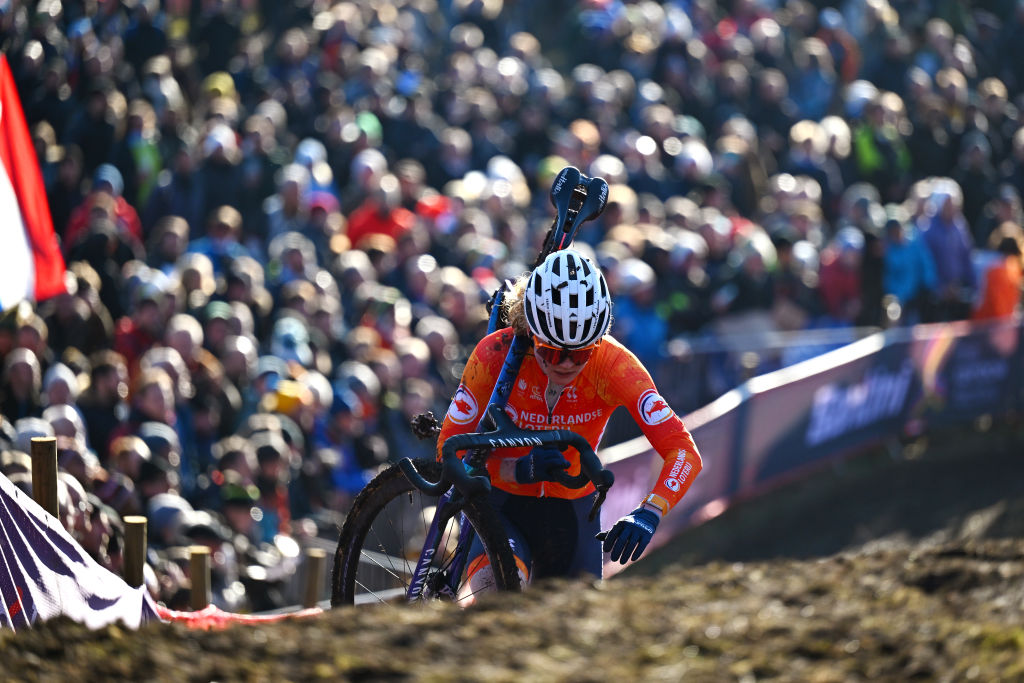Boonen vs Cancellara: Best of enemies
Exploring one of the sport's all-time great rivalries
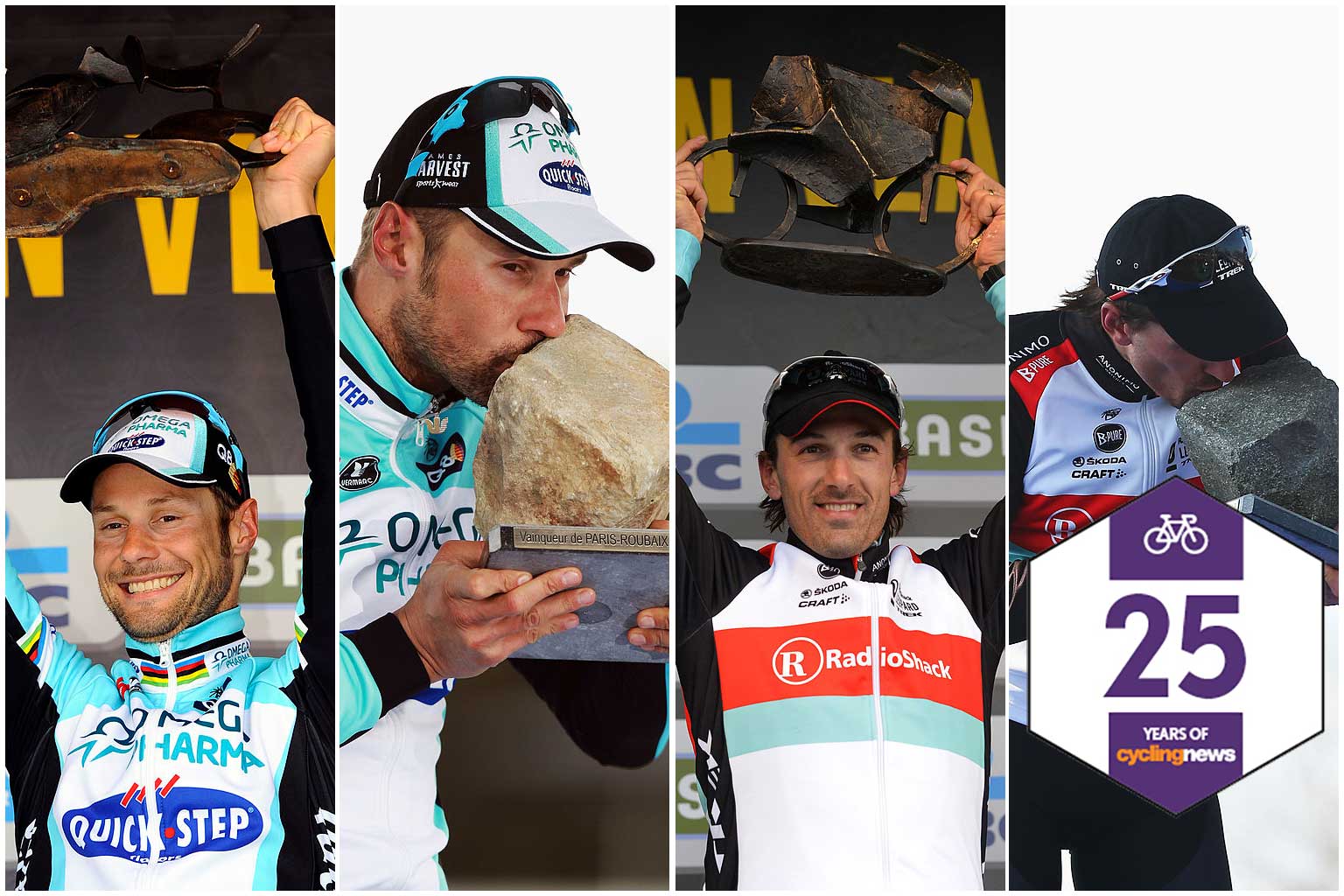
This year, Cyclingnews celebrates its 25th anniversary, and to mark such an important milestone, the editorial team will be publishing 25 pieces of work that look back at the sport over the last quarter of a century.
Rivalries are an integral part of the entertainment of sport. They elevate the great to the iconic. History is littered with them, but it is rare that you find two athletes reaching the peak of their talents at the same time. So often there's one that plays the underdog, or who enters the twilight of their career while the other is on the ascendency.
In the 25 years since Cyclingnews began publishing, there is one rivalry that has stood above so many others. Tom Boonen and Fabian Cancellara dominated the cobbled Classics for over a decade, taking 13 wins and 23 podium finishes at Paris-Roubaix and the Tour of Flanders between 2002 and 2016. They are also the only riders to have done the Ronde-Roubaix double twice.
There were only four years during that time that neither made it to the podium in at least one of the two cobbled Monuments. On pure figures, Boonen’s hit rate was marginally better, but figures do not tell the whole story. At their peak, there was little between them.
"They were very even, though they had some different qualities," long-time Tour of Flanders race director Wim Van Herreweghe tells Cyclingnews. "They were the icons of the generation. Normally in a rivalry you have an old guy who is getting worse and the new one is coming up. They came together and they had 10 to 15 years racing together."
Boonen himself summed it up in an interview with journalist James Startt for Bicycling magazine: "The thing with Fabian is that, when we are both in shape, we are pretty similar. The only difference is that he has a little more endurance, and I am a little faster."
The beginning
Five months separate Boonen and Cancellara in age, and their journey into professional cycling happened at a similar time. It was Cancellara who dipped his toes into the water first at the formidable Mapei-QuickStep team in 2001.
The latest race content, interviews, features, reviews and expert buying guides, direct to your inbox!
Cancellara’s pedigree was already apparent, with two junior world time trial victories and second in the under-23 event in 2000. Some riders don’t live up to their younger performances as they struggle to make the transition to the professional peloton but there were no such problems for the Swiss, who got to winning almost immediately, taking the Tour of Rhodes two months into the season.
Boonen’s foray into the top ranks came a year later but it was no less emphatic. Having ridden for them as a stagiaire in 2000, Boonen rode for the US Postal Service team in 2002. He had shown plenty of promise the previous year, finishing eighth in the U23 Tour of Flanders second in the U23 Liège-Bastogne-Liège and fourth at Paris-Roubaix espoirs, but few could have expected him to make the start he did.
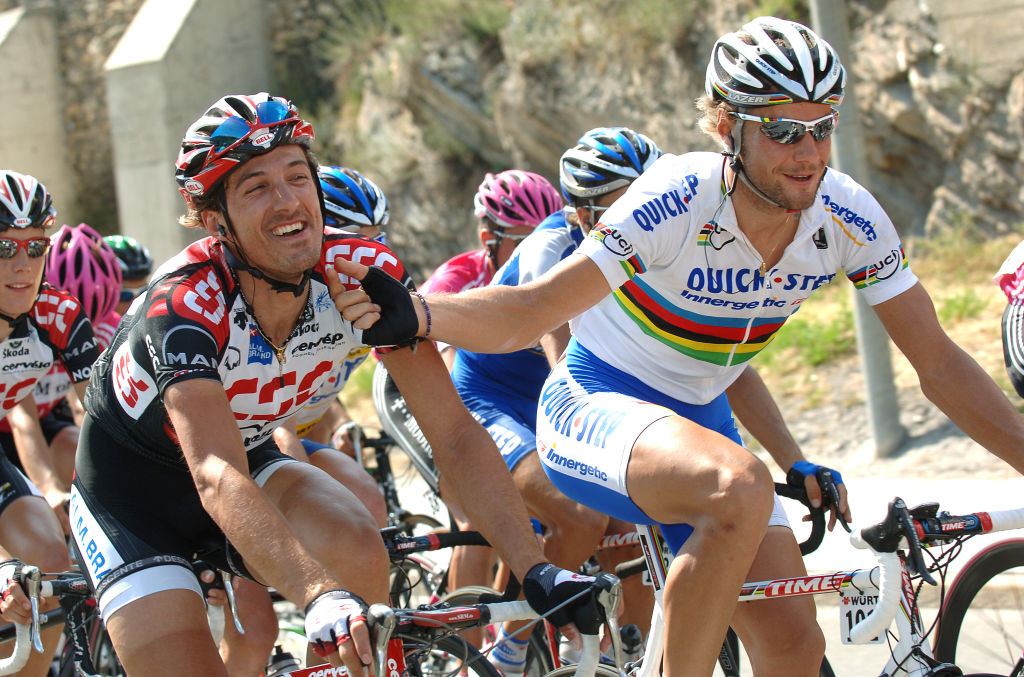
Initially riding for George Hincapie, Boonen was shunted into the forefront at the 2002 Paris-Roubaix when his team captain crashed. Having been in the early breakaway, the 21-year-old pushed on to the velodrome to take third place, just over three minutes behind Johan Museeuw. His performance was such that the so-called Lion of Flanders instantly dubbed him 'the next Museeuw'.
While it was clear that Boonen and Cancellara were stars in the making, the first seeds of their rivalry took time to germinate. Cancellara’s early racing programme focused on time trials and short stage races, and it wasn’t until he moved to Fassa Bortolo in 2003 that he made his Classics debut.
The makings of a rivalry
Though the Swiss man’s early attempt at De Ronde and the Hell of the North did not deliver anything like Boonen’s elite debut, it was clear early on that he was adept on the pavé. Cancellara’s time trial skills better suited the power required for Paris-Roubaix, and the French race would be where he began to make his name at the Classics. He fell just short of the podium in a four-way sprint on his second attempt at Paris-Roubaix, but he took the disappointment in his stride.
"It's a pity to finish fourth, but I think that to win a race like this, it's first necessary to lose it," Cancellara told the press afterwards. "When I first entered the velodrome, I had goosebumps and I found very little energy to do the sprint. I think it will be a feeling that I'll remember for a long time."
Boonen, who had gone into the race off the back of victories at E3 Harelbeke and Gent-Wevelgem but was riding for Museeuw, had to settle for ninth. With Museeuw out of the picture in 2005, Boonen was unleashed and joined the rare club of riders who had won the Ronde van Vlaanderen and Paris-Roubaix in the same year.
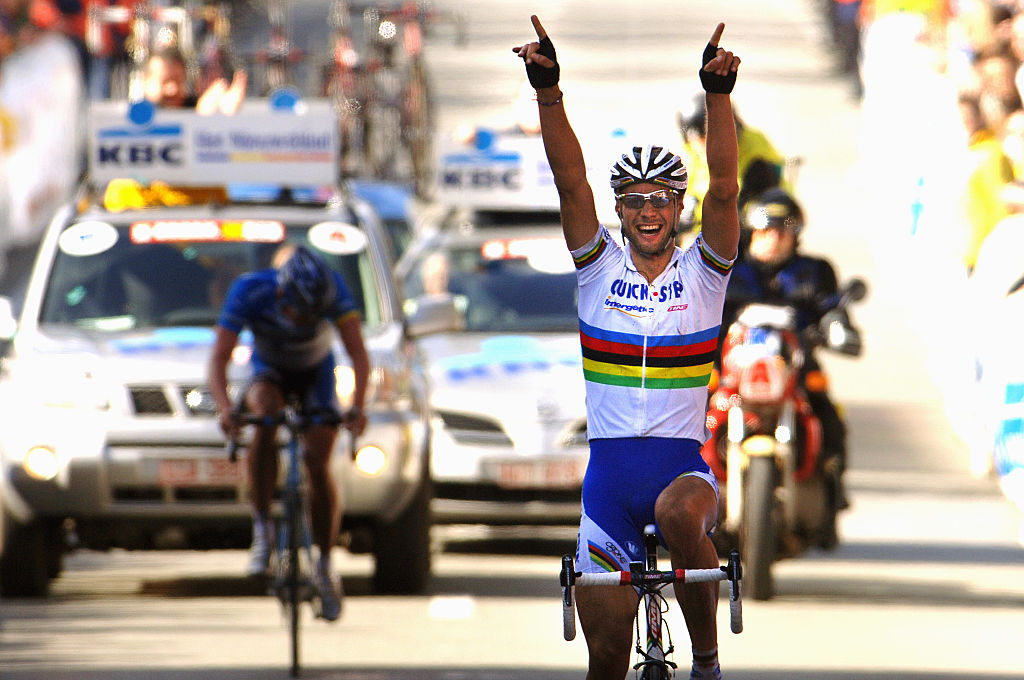
It wasn’t until 2006 that Boonen and Cancellara really went head-to-head when they split the two cobbled monuments between them. Wearing the rainbow bands of world champion, and after claiming his third straight E3 Harelbeke earlier in the spring, Boonen drew first blood with a commanding victory from a two-man escape at De Ronde.
The roles were reversed a week later as Cancellara took control of Paris-Roubaix. Aided slightly by a passing train blocking his chasers, Cancellara rode almost 20 kilometres alone to win by more than a minute. Boonen was the fifth rider to cross the line but he was elevated to second place after the three riders ahead of him were disqualified for riding through a closed level crossing.
2008 Paris-Roubaix: Mind games
Boonen and Cancellara faced off many times, but some contests stood out above them all. One of those was the 2008 Paris-Roubaix. Cancellara arrived at that year’s cobbled Classics off the back of a strong season opening, with victory at Strade Bianche and time trial success at Tirreno-Adriatico, all topped off by his second monument title at Milan-San Remo.
A second Paris-Roubaix title would put him in an elite club of three who had won the Italian and French Monuments in the same season - Cyrille Van Hauwaert and Sean Kelly were the only riders to have done it previously, in 1908 and 1986 respectively. John Degenkolb would join the club in 2015.
Boonen’s journey to the 2008 cobbled Classics was more muted but he had still showed his sprinting prowess with near-total dominance at the Tour of Qatar and a stage win at the Tour of California.
Despite the early season success, Cancellara endured a disappointing Flanders, stating later that he "felt like pudding" during the race. He blamed it on a poor build-up and told the press that he had turned things around for Paris-Roubaix.
He even had a little jibe for Boonen: "Last week Tom was already saying that he is so strong, but if you're that strong then I think you need to win race. For a lot of riders, it's the last chance to win, so there's a lot of pressure on their shoulders."
During their rivalry, Cancellara and Boonen were never afraid to play mind games with each other ahead of big races. However, it was always done with a hefty level of respect towards each other. You’d struggle to find two rivals being the best of friends with each other and Boonen and Cancellara were unlikely to hang out over a coffee, but their rivalry was never bitter. Each one knew that the contest between them only elevated their status and they both seemed to enjoy going toe-to-toe.
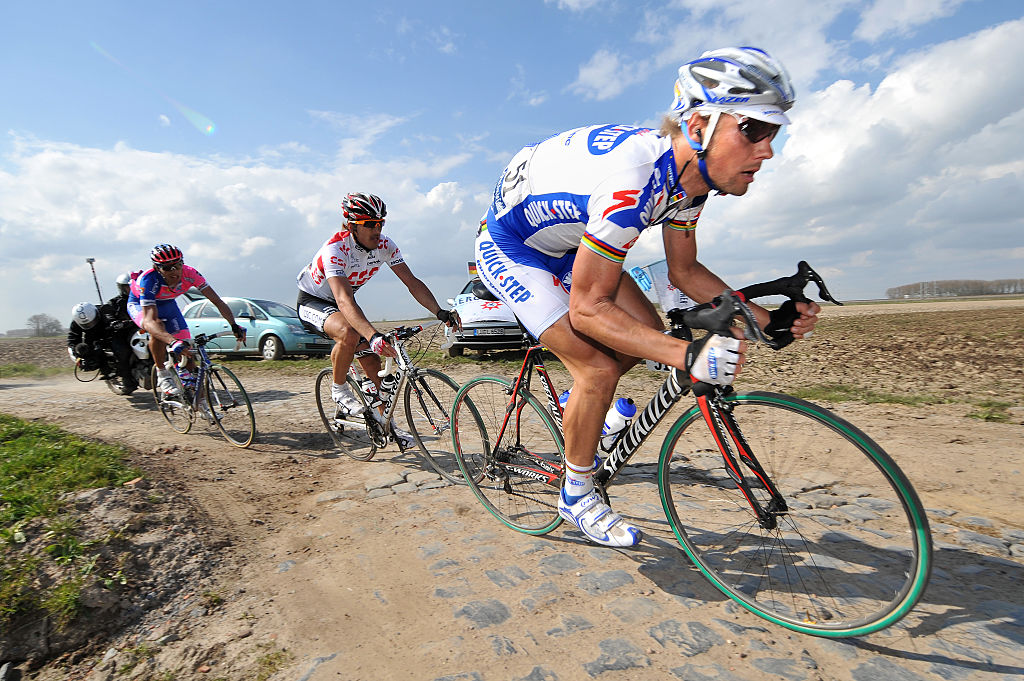
Boonen’s 2008 cobbled Classics campaign had been slightly more successful than Cancellara’s but, as was pointed out, he had not once taken a win - nor had he been on the podium. Nevertheless, he would go into Roubaix as joint leader with Stijn Devolder, who had just won his first of two consecutive Flanders titles. Meanwhile, Cancellara had defending champion Stuart O’Grady in his team.
The first major selection came in the Troueé de Arenberg, and Cancellara’s CSC team and Boonen’s QuickStep squad were both well represented in the ever-dwindling group of favourites with five riders each, including the duo.
Johan Vansummeren drew out the favourites, including Boonen, Cancellara, O’Grady and Devolder, with an attack on Auchy-lez-Orchies. QuickStep then launched a move with Devolder on Mons-en-Pévèle, forcing O’Grady to chase him. Vansummeren was forced to drag the pair back, setting the scene for a final Cancellara versus Boonen battle.
The moment they were caught, Boonen launched a move on the road leading to the short Templeuve-L’Epinette sector. Cancellara was hot on his tail along with Alessandro Ballan, who had been keeping a low profile without any teammates in the group of favourites. Wary of Boonen’s sprint, Cancellara tried to shake distance his companions on the Carrefour de l’Arbre but the three would ride into the Roubaix velodrome together.
One inside the velodrome, the race was Boonen’s to lose and the other two knew it. Boonen was not taking anything for granted, however, and made his move on the final bend. Having had a response to everything that had been thrown at him during the race, Cancellara could do nothing but watch Boonen storm towards the line for his second Roubaix title, while he edged out Ballan for second.
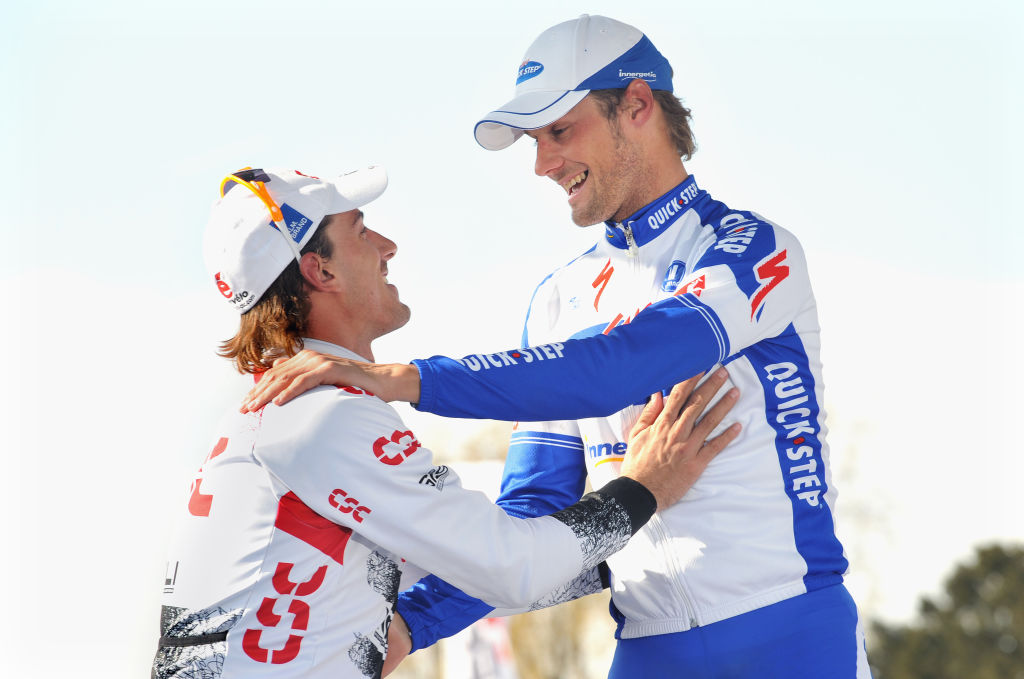
2010 Tour of Flanders: The infamous attack on the Muur
Perhaps one of the most iconic images of Boonen and Cancellara was the scene of them, donned in their respective national champion’s kits, riding up the Muur van Geraardsbergen during the 2010 Tour of Flanders. Cancellara distancing Boonen with relative ease on the steep curving slope to the church is one of the most discussed of their battles, though predominantly for the wrong reasons.
Both riders went into Flanders as favourites after a commanding showing at E3 Harelbeke. Boonen had made the race-defining move on the Paterberg but it was Cancellara who made the race-winning attack inside the final kilometre, leaving Boonen to sprint for second against Juan Antonio Flecha.
Cancellara’s performance was such that Boonen labelled him the favourite for Flanders, though it’s more than likely there were some mind games going on here. Riders prefer to deflect the badge of pre-race favourite onto one of their rivals to alleviate some of the pressure and place it on a competitor. Cancellara seemed all too happy to shoulder the pressure, telling the media before the race he was sure he could shake off Boonen.
"What I did at Harelbeke was special - I saw that I can go with Boonen on the climbs and then drop him on the flat," he said at the time. Cancellara was never shy about asserting his capabilities.
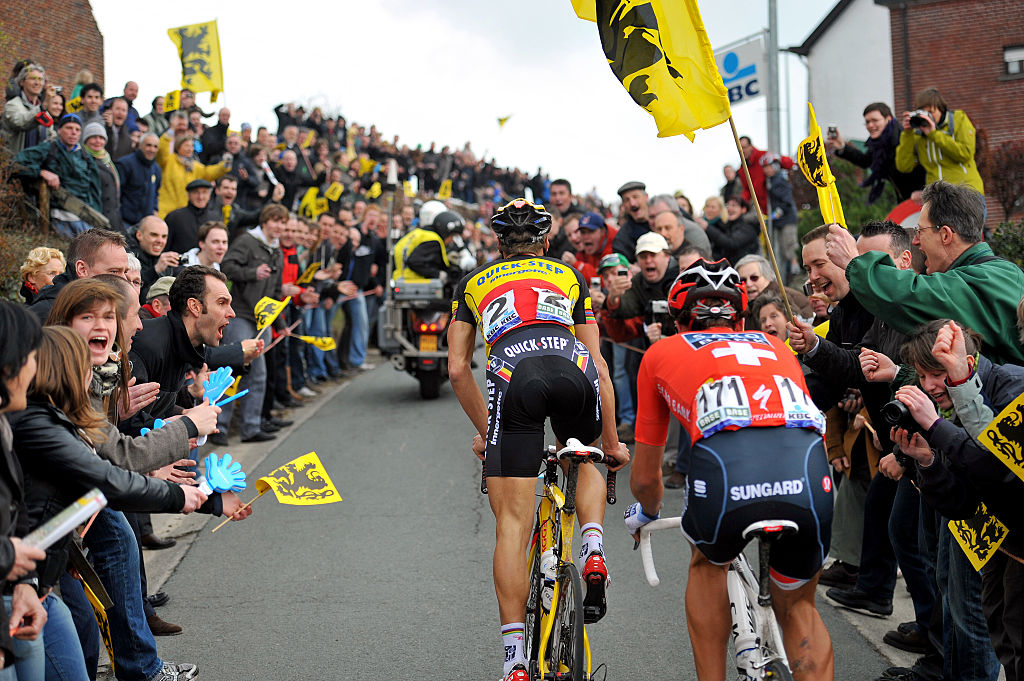
In the end, he didn’t have to wait for the flat section. In a reversal of E3, it was Cancellara that made the first move on the Molenberg as the peloton passed a group of late attackers. Alert to the danger, Boonen was on his wheel almost immediately and they made quick work of building a gap on those behind.
As they hit the Muur van Geraardsbergen inside the final 18 kilometres, the duo had over 40 seconds over their nearest chaser. Cancellara that took control on the lower slopes and Boonen was content with riding his wheel, for now. The Belgian champion eventually moved to the front when the climb got steeper as it moved out of town.
Approaching the toughest part of the ascent as it wound its way around a seemingly never-ending corner, Boonen stood onto his pedals trying to put every ounce of power he had into them while Cancellara sat resolutely in his saddle. Sensing weakness, Cancellara accelerated and put over 10 seconds into Boonen before the top of the climb as the Belgian wrestled with his bike.
With just the Bosberg remaining, Cancellara was able to use his time trial skills to hammer out a significant advantage over Boonen. There was nothing Boonen could do but limit the damage and hold off the chasers behind. In the end, Cancellara rode into Ninove with more than a minute to spare and ample time to celebrate his first Ronde van Vlaanderen victory, only the second Swiss to do it since Heiri Suter in 1923. Cancellara went on to win Paris-Roubaix a week later, taking the first of his doubles.
The battle on the Muur would go down as one of Cancellara and Boonen’s best battles but a video published over a month later would forever taint the race and its outcome. The maker of the video, which is still available online, accuses Cancellara, with what they deem 'incontrovertible evidence', of motor doping. Cancellara has always denied it and no definitive proof has ever been found but, whether or not there is any truth in it, the race will forever be tainted by suspicion.
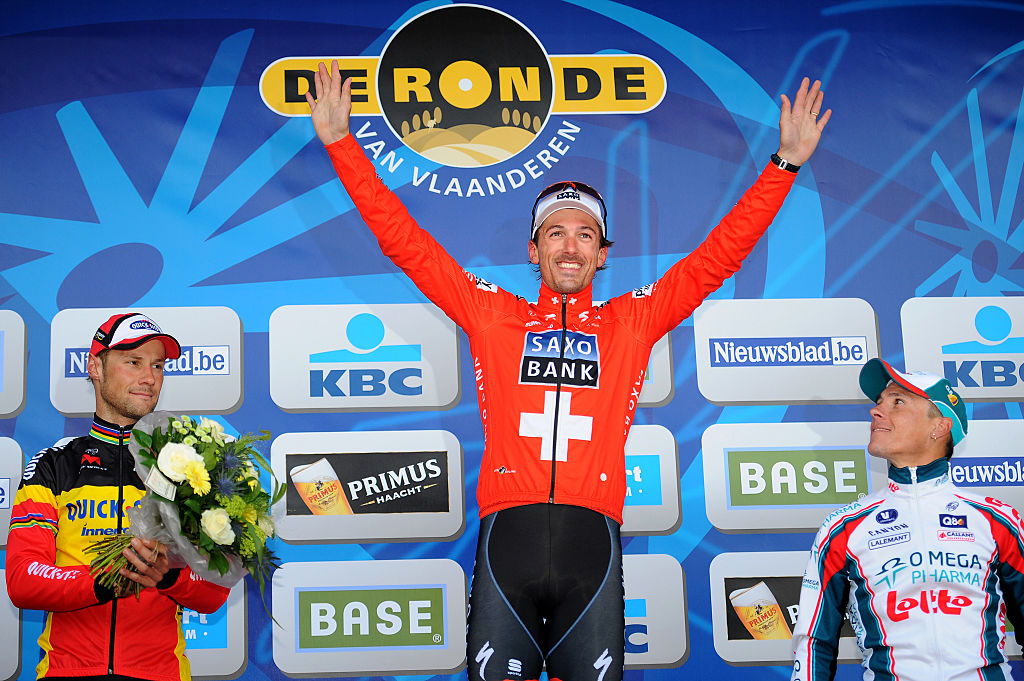
The end of an era
The start of my own cycling journalism career in 2012 coincided with the final years of their reign. Boonen’s last Monument title came that year with his second Flanders-Roubaix double, while Cancellara would take another double in 2013 and a final Flanders title the following year.
I was lucky enough to be on-site as Cancellara and Boonen rode their final Classics races in 2016 and 2017 respectively. After more than a decade competing at the top of the sport, they were household names in the pavé heartlands and would be given a hero’s send-off as they called time on their careers.
I have never seen anything that matches the send-off Boonen received in Antwerp ahead of his final Tour of Flanders in 2017 - the hushed excitement as the crowd waited for him to ride onto stage and the ear-bursting eruption of noise as he did so.
Though it might not have matched the same fervour as Boonen’s final appearance, Cancellara received a deafening ovation in his final Flanders bow. Through all his racing on the cobbles, he had been taken into the hearts of the Flemish fans. He, like Boonen, would be mobbed like a rockstar wherever he went.
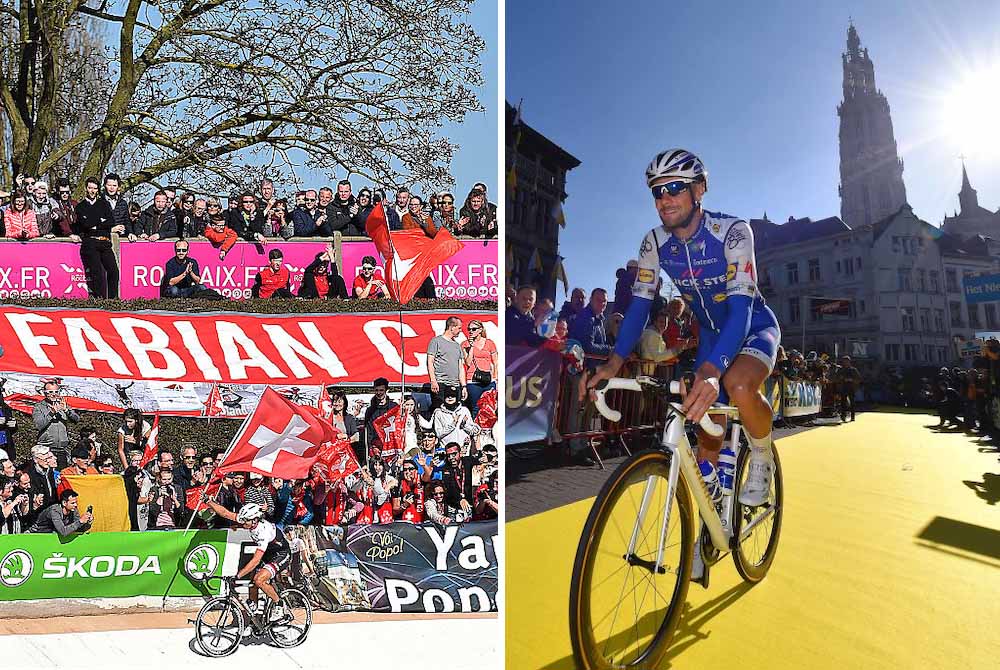
"Tom Boonen, in Flanders, he was more than just a cyclist alone, more than a sports personality, he was bigger than cycling alone. But Cancellara was also loved by the Flemish people," Van Herreweghe explains to Cyclingnews.
"They loved him, and they saw him like a Flandrien. He was a typical Flandrien and Classics rider and they are loved here in the region."
Right until the last, there was always a level of respect between Cancellara and Boonen and, in many ways, it made their rivalry even better. It is what we see between Mathieu van der Poel and Wout van Aert in the present day: another budding rivalry that seems destined for greatness.
Born in Ireland to a cycling family and later moved to the Isle of Man, so there was no surprise when I got into the sport. Studied sports journalism at university before going on to do a Masters in sports broadcast. After university I spent three months interning at Eurosport, where I covered the Tour de France. In 2012 I started at Procycling Magazine, before becoming the deputy editor of Procycling Week. I then joined Cyclingnews, in December 2013.
